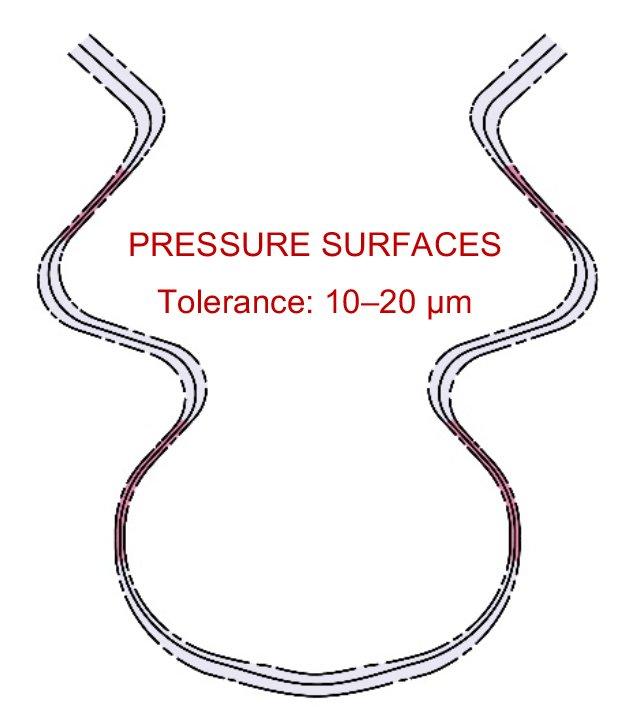Turbine and compressor discs have so-called fir-tree mounting slots into which the turbine blades are inserted. The established production methods for these mounting slots are broaching, wire cutting or milling. But these techniques produce burrs and sharp edges in the fir-tree slot. For flawless assembly and to prevent injuries, the edges of the fir-tree slot and blade root must be burr-free, with a defined radius. This is the only way to guarantee that the components function properly. In particular, the pressure surfaces that blade roots and discs are in contact with during operation are subject to very narrow tolerances of 10–20 µm. For the blades to be perfectly positioned, it is essential to prevent shape variation in pressure surfaces during
deburring and rounding.
REPEATABILITY – WHY ROBOTIC PROCESSES ARE NOT THE BEST CHOICE
Standard engineering practice for this process step is mechanical, semi-robotic deburring and rounding with grinding wheels or brushes. These tools used wear over time, producing inconsistent machining results over their life span. For example, sharp edges can slice off brush tips, make brush wear hard to predict, and therefore lead to varying results as well as heavy process contamination due to the brush residues. Likewise, grinding wheels are subject to uneven material removal, which the robot movements have to compensate for, and the abrasion causes process contamination.
On complex workpiece geometries, rounding results are often asymmetrical because the grinding wheels or brushes cannot be fine-tuned to the exact geometry of the fir-tree slot, or because they cannot get into hard-to-reach areas at all. These asymmetrical and inconsistent rounding results often fail to meet tolerances, cause shape variation and therefore increase both your reject rate and your costs.
COMPARING ALTERNATIVE PROCESSES
In the quest for an alternative process with convincing finishing results, an engine manufacturer worked with OTEC to evaluate two different mass finishing technologies.
The first process, in a round vibratory trough, proved inexpedient for the application: even after several hours of processing, it was unable to bring all the edge breaks within the tolerance range. The rounding produced in the tests was neither symmetrical nor repeatable. Furthermore, the increased noise level and associated vibrations were a problem given that sensitive measuring devices are used close by.
The second process, in the OTEC stream finishing machine, quickly achieved very promising results at the first
attempt. By positioning the component precisely, all the edge breaks were within tolerance in just 15 minutes, with highly symmetrical rounding along the entire edge. Additional runs confirmed that the process was repeatable and stable. Shape variation was less than 1 µm – so low that not a single adjustment was required in upstream broaching. Lastly, the low-noise, low-vibration process was suitable for use near sensitive measuring devices.
These advantages have already convinced several engine manufacturers:
- Minimal process time of just 15 minutes
- Highly symmetrical, uniform rounding
- Reliable, repeatable process results
- Residue-free burr removal
- Minimal shape variation in fir-free slot pressure surfaces
- Reliable, measurable compliance with narrow tolerances of less than 1 µm
- Purely mechanical material removal, without the use of chemical process accelerants
HOW DOES STREAM FINISHING WORK?
In mechanical stream finishing, which was developed in-house by OTEC, components such as turbine discs and turbine or compressor blades are clamped in a holder and immersed in a rotating
container filled with an abrasive or polishing medium (media). The workpieces can also be rotated or set at specific angles in the
media flow.
The relative motion between the component and the media produces an even finish. The enormous machining forces of up to 9 tons used in stream finishing can remove material faster and more precisely than any other type of surface finishing process:
depending on component size, initial state and preparation (e.g. pre-chamfering) they can produce a radius of up to 700 µm within 15 minutes. And because the media granules are so fine, the rounding process is also suitable for complex, hard-to-reach geometries.
OTEC is the only supplier of stream finishing machines with integrated automation for large and heavy components: the newly developed SF-HP is suitable for workpieces up to 650 mm in diameter and weighing up to 200 kg.
DEFINE YOUR PROCESS WITH THE HELP OF OTEC PRÄZISIONSFINISH EXPERTS
OTEC stream finishing technology is the ideal choice for components with similarly demanding post-processing requirements.
Examples include turbine and compressor blades, turbine blade roots, blisks, servo valves, gear wheels, ball screw nuts and landing gear components. Our specialist team at the OTEC Finishing
Center is ready to assist in defining your process – whatever the geometry, surface quality or rounding requirements. Work with us to identify exactly the right process for your component. Arrange an appointment today to watch your sample being processed,
either in person or virtually.
OTEC GmbH Präzisionsfinish provides precision technology for achieving perfect surfaces. OTEC machines are used for smoothing, polishing, precision edge-rounding and deburring on a variety of workpieces, with the aim of improving surface quality. OTEC has a global presence supported by international business partners. OTEC’s comprehensive, market-leading technical expertise in developing the perfect interplay of machine and abrasive benefits a wide range of industries including food, tooling, medical devices, jewellery, and automotive and aerospace.
OTEC Präzisionsfinish GmbH
Heinrich-Hertz-Straße 24
75334 Straubenhardt
Telefon: +49 (7082) 4911-20
Telefax: +49 (7082) 4911-29
http://www.otec.de
Telefon: +49 (70) 824911-20
E-Mail: a.kofler@otec.de
![]()
